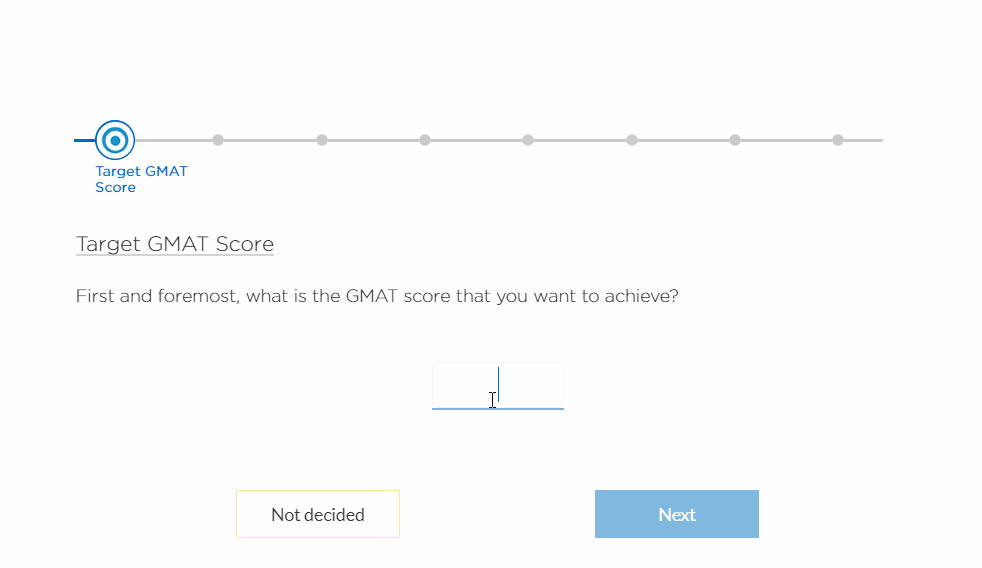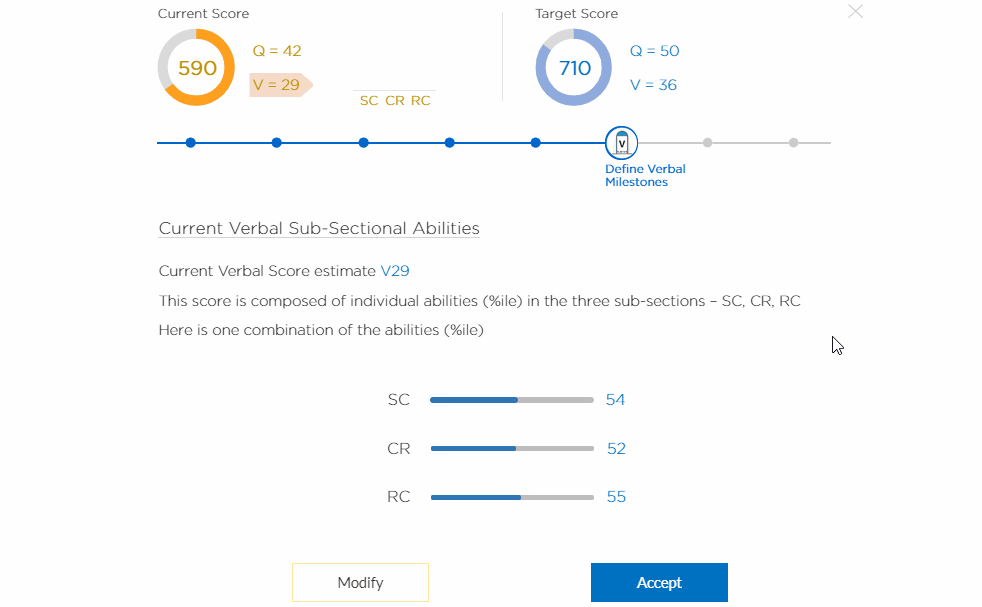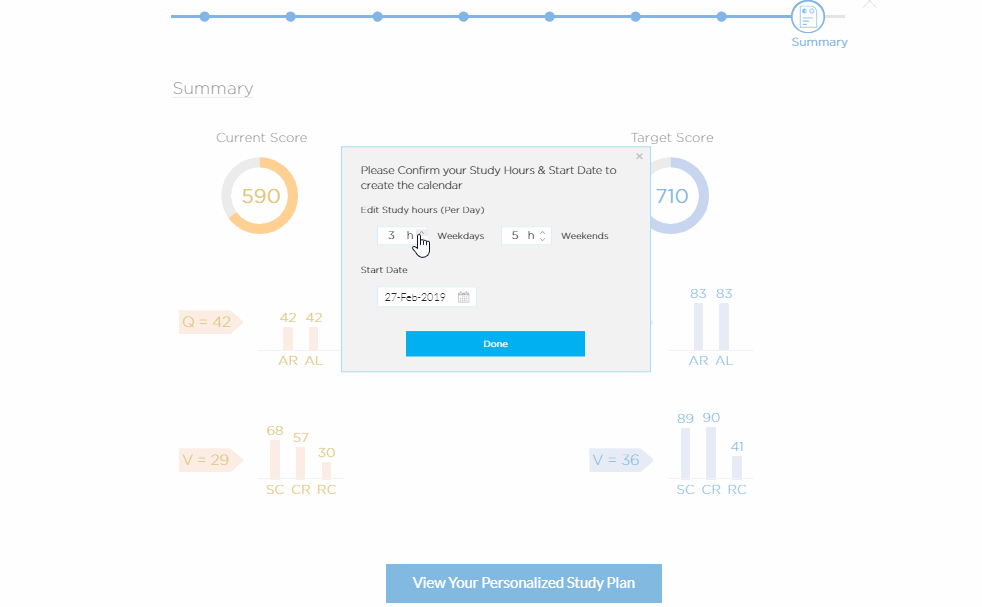Are you taking the GMAT for the first time and wondering how to get a 700+ score? While everyone wants to score above 700 only 12% of GMAT test-takers can get to that score. So, what it is that most test-takers who get to 700 do? Well, to begin with, they plan their study well. It more than doubles the odds of reaching your target GMAT score.
The next question then is to understand what goes into a well-defined Personalized Study Plan?
The most important features of a well-defined study plan are:
- It has well-defined milestones based on individual strengths and weaknesses and the target score
- It lays down a logical sequence of study
- It provides a realistic GMAT date based on a committed study schedule
If you have just started your GMAT preparation, you must be wondering how you can get a study plan without having a clear idea about your starting abilities or strengths. Do not worry! In this article, you will learn how our brand-new tool – Personalized Study Planner can help you build the study plan.
This tool will also help you save 2-3 hours of effort that typically goes into creating a study plan. You can create your personalized study plan in less than 5 minutes!
Read more about the features of Personalized Study Planner here
Steps to create a Personalized Study Plan in less than 5 minutes
In this section, we will see an overview of the steps that you will follow to get a highly personalized study plan. In a few swift steps, you will get your personalized study plan so that you can get cranking at the course. It is okay if you don’t have all the information right away, the tool will provide suggestions. Once you have a better idea, you can edit the plan accordingly.
Let’s get started with the plan!
Step 1: Get a realistic estimate of your GMAT date

The first step is to set a target GMAT score. If you have not decided on a target yet, you can select the ‘Not Decided’ button. The system will recommend a score of 710 which corresponds to a 90%tile. This score is around or above the median GMAT score for most programs and therefore would be an excellent score to target.
Once you have decided on the target, it is important to know from where you are starting to draw the path. If you are not sure of your current abilities, select ‘Don’t have a current score.’ The system recommends setting your current score to 50%tile which is nothing but the median score of all GMAT test-takers.
For this current score, the system assumes you have similar abilities in both Quant and Verbal. If you feel more comfortable in one section as compared to the other, you can go ahead and change the scores by clicking on ‘Manually Enter Score.’
Based on the strengths and weaknesses identified in the previous step, the system will show you the target score for Quant and Verbal. You can again choose to change the targets by selecting the ‘Manually Enter Score’ option. Your path can be either Verbal heavy or Quant heavy depending on what you are strong in.
Anupriya achieved a GMAT score of 760 with a Q48 and a V46 by leveraging the Verbal section. While Dhananjaya scored a 760 on the GMAT with a Q50 and a V42 by leveraging Quant section.
Based on the inputs received so far the system will show you the week in which you can plan for the GMAT. The following assumptions underlie the suggested date:
- You start your GMAT Preparation from the next day of creating this plan
- You will set aside/devote a minimum of 20 hours per week towards preparation
- You will use a data-driven online course that will help you track your preparation and course correct.
This is an initial estimate based on your inputs so far. A final estimate, which is more precise, is then created in the next stage based on the individual sub-sections current and target abilities.
Tip #1: You must make sure that you select your target score carefully. A good target score would be the median score of your desired program. If you are looking at getting scholarships, you must target around 30 points higher than the median score. In this example, we would take a target score of 750. Check FAQ #3 on this screen to find out the median scores of the schools* or read this article outlining the median scores of top business schools in the US and Europe.
Step 2: Determine the Milestones that lead to your target score

Click here to go to the Personalised GMAT Study Planner
In this stage, the system uses more precise information to define your path to the target score.
Your Verbal score is composed of SC, CR and RC sub-sectional score,s and Quant is composed of Arithmetic and Algebra scores. The system gives you these sub-sectional score combinations for your current Verbal, and Quant scores entered earlier. If you know the exact abilities or want to change the estimates as per your comfort level, you can do so by clicking on the ‘Modify’ button.
Now, based on the strong and weak areas defined in the above step, the system gives you the targets/ milestones that you need to reach in each sub-section for achieving your overall target score. You can again update the combination by clicking on ‘Modify.’
Note: You can use the lock function to change more than 1 sub-sectional score. You will be allowed to change only 2 sub-sectional scores at the most. The system will calculate the third score by itself based on your total Verbal score.
The system will also calculate and display the approximate time required to hit your target verbal sub-sectional scores.
Tip #2: Use the Lock option next to sub-sectional scores while modifying scores to set more than 1 Verbal sub-sectional scores. This will help you input precise values in the system.
Step 3: Get the Final Study Plan

You can access the Personalised GMAT Study Planner here
In this stage, you get the final study plan in calendar form. Our recommendation is to start with the section that you are stronger in; this is the default setting in the calendar view that is displayed. This helps you in building much-needed momentum and confidence in your GMAT Preparation.
You can also change the amount of time you will spend on weekdays and weekends doing GMAT preparation, based on your schedule. Not just that, if you have prior commitments on any day or you are taking a holiday from work during the preparation period, you can change the number of hours you would be studying on a particular day by clicking on that day.
On this view, you also get to see the more precise estimate of the GMAT date mentioned earlier. This date considers 7 days for taking 2 mocks and working on the test-taking strategy and revision.
Tip #3- You can change study hours for a particular day by clicking on that day. You can, therefore, account for no-study days or days where you can study more than you do on other days.
Summary
Now that you have gone through the steps to create the Personalized Study Plan, let’s quickly look at the best practices and summarize things you need to keep in mind while creating the plan.
- Even without having precise information the tool allows you to create a personalized study plan, to begin with.
- To make the plan more customized learn about your current and target scores.
- Aim for 30 points higher than the median score of your target programs.
- Take a mock test to know your starting Q and V scores. This will help you chose a path that leverages your strength.
- Make sure your mocks also give you information about the sub-sectional scores (SC, CR, RC, Alg, Ar). This will again help you leverage your strength and reduce the prep time.
- Take note of the MILESTONES (target abilities or percentiles) that you finalize in the plan. A milestone-driven study plan makes you twice as likely to achieve your target score.
- Lastly, whether you have a GMAT date in mind or not you should take note of the amount of effort or study hours required to ace the test. Be diligent enough to put in that time.
PLAN. EXECUTE. ACE.
P.S. You can write to us at acethegmat@e-gmat.com with your questions.















